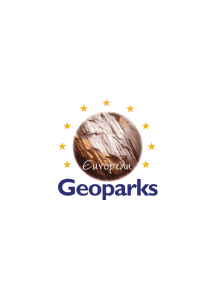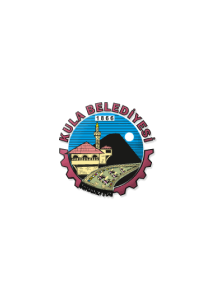Kula Volcanic Park
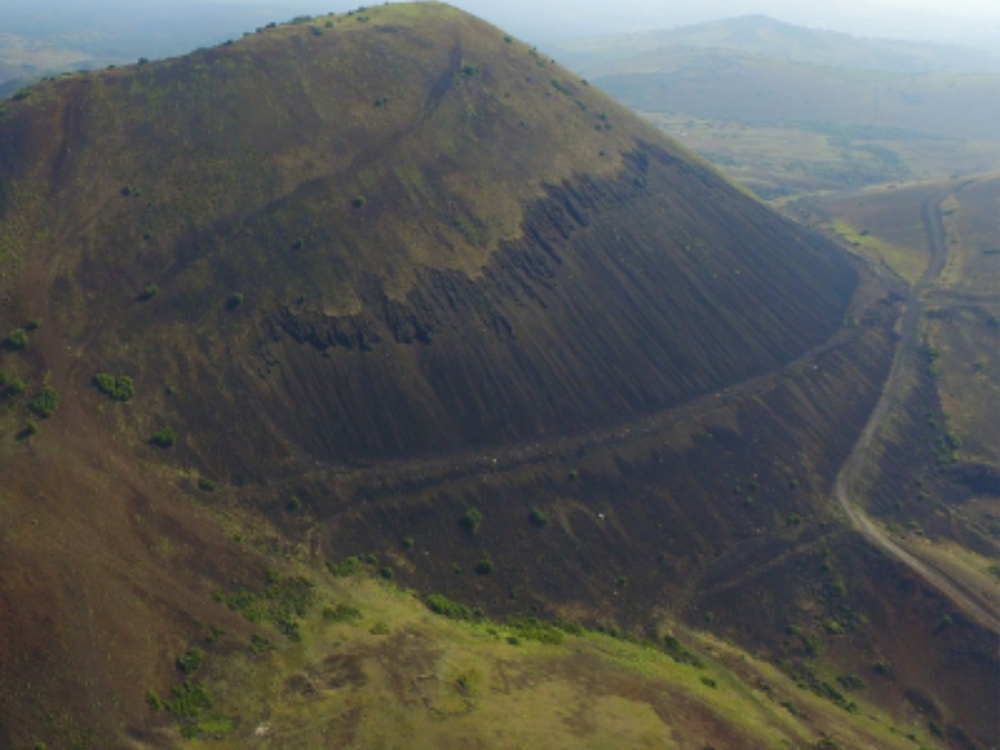
The Kula Divlit Volcanic Park is located in the Kula-Salihli Geopark, northeast of the Kula district. This park contains all of the landforms that resulted from the third stage of volcanic activity. The Kula-Divlit cinder cone, AA types lava flow, parasitic cones, spatter cones, and lava tunnels and ditches can all be found within the park area. Within the park, there is a 2.7-kilometer-long pathway with wooden bridges and one bicycle track that leads visitors to the geosites (approx. length 34.8 km).
First-Phase volcanism (Burgaz Volcanics); This phase of volcanism took place about 1.7 million years and the lava flows dating from this period formed very thick basalt sheets making the high plateaux of the current topography (e.g. the plateau of Burgaz, Sarnıç and İbrahimağa). You can see very well developed columnar basalt structures on these basalt flows.
Second- Phase volcanism (Elekçitepe Volcanics); In the second phase as a result of volcanism that took place between 200 and 130 thousand years period volcanoes formed. According to some sources, 45 volcanic cones, and while some other sources state 49 volcanic cones were formed in this period.
Third- Phase volcanism (Divlit Tepe Volcanics): The third phase, which covers the period between 30000 and 2600 years ago, consists of various slag cones and lava flows and the young volcanic cones forming the third stage volcanoes are locally called “Kula Divlits” and these volcanoes constitute the third and latest phase of volcanism at Kula. This last phase of volcanic activity, has quite a fresh appearance and gives visitors the feeling that this volcanism happened only yesterday. The lavas with their dark black colours can easily be distinguished from the other lavas belonged to the earlier stages of volcanism in the area. Since they are very young and well protected, you can clearly see the structures of a basaltic lava flow.
The Geosites which can be visited within the Kula Divlit volcanic park are:
Kula Divlit Volcano Cone
First-Phase volcanism (Burgaz Volcanics); This phase of volcanism took place about 1.7 million years and the lava flows dating from this period formed very thick basalt sheets making the high plateaux of the current topography (e.g. the plateau of Burgaz, Sarnıç and İbrahimağa). You can see very well developed columnar basalt structures on these basalt flows.
Second- Phase volcanism (Elekçitepe Volcanics); In the second phase as a result of volcanism that took place between 200 and 130 thousand years period volcanoes formed. According to some sources, 45 volcanic cones, and while some other sources state 49 volcanic cones were formed in this period.
Third- Phase volcanism (Divlit Tepe Volcanics): The third phase, which covers the period between 30000 and 2600 years ago, consists of various slag cones and lava flows and the young volcanic cones forming the third stage volcanoes are locally called “Kula Divlits” and these volcanoes constitute the third and latest phase of volcanism at Kula. This last phase of volcanic activity, has quite a fresh appearance and gives visitors the feeling that this volcanism happened only yesterday. The lavas with their dark black colours can easily be distinguished from the other lavas belonged to the earlier stages of volcanism in the area. Since they are very young and well protected, you can clearly see the structures of a basaltic lava flow.
The Geosites which can be visited within the Kula Divlit volcanic park are:
Kula Divlit Volcano Cone
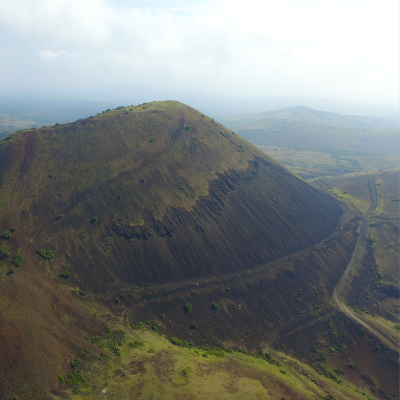
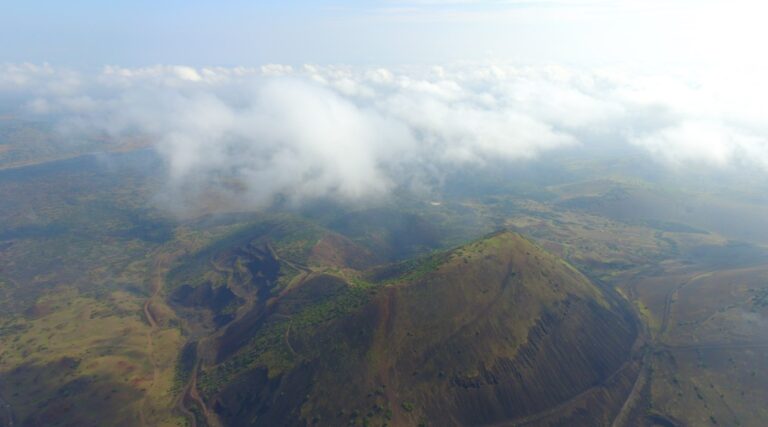
It is one of the most spectacular volcanoes formed in the third phase of volcanism at Kula (Divlit Tepe Volcanics). It shows cinder or scoria cone characteristics in terms of its formation and shape properties. Cinder cones are steep slope volcanic cones that have been formed by the accumulation of various sized materials (pyroclastic materials) that are spattered out from the volcano chimney and solidify in the air. The solid material forming the cone can be of a very different size, from very fine-grained ash size material to volcanic bombs of a size that can exceed 1 meter in diameter.
The scoria forming the Kula-Divlite cone generally consists of loose material that is hazelnut or lentil-like size of a black-dark brown colour. The height of the cone is 860 m above the sea level and its relative elevation is 170 m. The Kula-Divlit cone is one of the monumental natural structures of the Kula Volcanic Park and is one of the youngest volcanic cones in Turkey.
The Kula-Divlit Lava Flows:
The major eruptive product of the Kula volcanoes was lava. Lava flows are the streams of molten rock that pour out from the ground from an erupting vent. The Kula-Divlit lava flows formed as a result of the rising up of the high-temperature basaltic-lava and its overflowing on to relatively lower altitudes in the vicinity of the cone and these flows of molten rock solidified in time. The approximate area of the lava flow is 20,73 km2.
The Kula Volcanic Park consists of Divlit Volcanic Cone, parasitic cones and various forms of lava flows. Some of the basaltic lava flows, which came from the Kula Divlit volcano and also spread out from parasitic cones, came into the former valley and spread some 20 km to the north, flowing into the main Gediz Valley by the Hoca Seyfettin Bridge where it blocked the main river several times. These lava flows, which generally flow in a northerly direction, have solidified over time and have formed a rough structure which is difficult to walk on. This type of lava is called “AA Lavas" in the Hawaiian language. Because of their very young age few plants are able to grow on these lava flows.
The scoria forming the Kula-Divlite cone generally consists of loose material that is hazelnut or lentil-like size of a black-dark brown colour. The height of the cone is 860 m above the sea level and its relative elevation is 170 m. The Kula-Divlit cone is one of the monumental natural structures of the Kula Volcanic Park and is one of the youngest volcanic cones in Turkey.
The Kula-Divlit Lava Flows:
The major eruptive product of the Kula volcanoes was lava. Lava flows are the streams of molten rock that pour out from the ground from an erupting vent. The Kula-Divlit lava flows formed as a result of the rising up of the high-temperature basaltic-lava and its overflowing on to relatively lower altitudes in the vicinity of the cone and these flows of molten rock solidified in time. The approximate area of the lava flow is 20,73 km2.
The Kula Volcanic Park consists of Divlit Volcanic Cone, parasitic cones and various forms of lava flows. Some of the basaltic lava flows, which came from the Kula Divlit volcano and also spread out from parasitic cones, came into the former valley and spread some 20 km to the north, flowing into the main Gediz Valley by the Hoca Seyfettin Bridge where it blocked the main river several times. These lava flows, which generally flow in a northerly direction, have solidified over time and have formed a rough structure which is difficult to walk on. This type of lava is called “AA Lavas" in the Hawaiian language. Because of their very young age few plants are able to grow on these lava flows.
Parasitic Cones
In the volcanic park there are some small cone-shaped volcano structures in the vicinity of Kula-Divlit Volcanic cone. These are called parasitic cones. A parasitic cone is the cone-shaped accumulation of volcanic material, not forming part of the central vent of a volcano. They form in eruptions from fractures on the flank of the volcano. These fractures occur because the flank of the volcano is unstable. Eventually, the fractures reach the magma chamber and generate eruptions called flank eruptions, which, in turn, produce a parasitic cone.
Spatter Cones and Spatter Ramparts
In Kula divlit volcanic park, you can see various forms of spatter cones or spatter ramparts on the lava flow. A spatter cone is a low, steep-sided hill or mound that consists of welded lava fragments, called spatter, which formed around a lava fountain issuing from a central vent. Typically, spatter cones are about 3–5 meters high. Spatter cones and spatter ramparts are typically formed by lava fountaining associated with mafic, highly fluid lavas, such as those erupted in the Hawaiian Islands. As blobs of molten lava, spatter, are erupted into the air by a lava fountain, they can lack the time needed to cool completely before hitting the ground. In the case of a linear fissure, lava fountaining will create broad embankments of spatter, called spatter ramparts, along both sides of the fissure.
Spatter cones are more circular and cone-shaped, while spatter ramparts are the linear wall-like features.
Lava Tunnels - Lava Tubes:
Some of the fantastic volcanic structures found in the Kula-Devlet volcanic park consist of lava tunnels. A lava tunnel is a type of lava cave formed when a low-viscosity lava flow develops a continuous and hard crust, which thickens and forms a roof above the still-flowing stream of lava. Lava tubes form in one of two ways: either through the crusting over of lava channels or from pāhoehoe flows, where the lava is moving under the surface. Lava usually leaves the point of eruption in channels. These channels tend to stay very hot as their surroundings cool. This means they slowly develop walls around, them as the surrounding lava cools and/or as the channel melts its way deeper. These channels can go deep enough to crust over, forming an insulating tube that keeps the lava molten and serves as a conduit for the passage of the flowing lava.
. These types of lava tubes tend to be closer to the lava eruption point.
In the volcanic park there are some small cone-shaped volcano structures in the vicinity of Kula-Divlit Volcanic cone. These are called parasitic cones. A parasitic cone is the cone-shaped accumulation of volcanic material, not forming part of the central vent of a volcano. They form in eruptions from fractures on the flank of the volcano. These fractures occur because the flank of the volcano is unstable. Eventually, the fractures reach the magma chamber and generate eruptions called flank eruptions, which, in turn, produce a parasitic cone.
Spatter Cones and Spatter Ramparts
In Kula divlit volcanic park, you can see various forms of spatter cones or spatter ramparts on the lava flow. A spatter cone is a low, steep-sided hill or mound that consists of welded lava fragments, called spatter, which formed around a lava fountain issuing from a central vent. Typically, spatter cones are about 3–5 meters high. Spatter cones and spatter ramparts are typically formed by lava fountaining associated with mafic, highly fluid lavas, such as those erupted in the Hawaiian Islands. As blobs of molten lava, spatter, are erupted into the air by a lava fountain, they can lack the time needed to cool completely before hitting the ground. In the case of a linear fissure, lava fountaining will create broad embankments of spatter, called spatter ramparts, along both sides of the fissure.
Spatter cones are more circular and cone-shaped, while spatter ramparts are the linear wall-like features.
Lava Tunnels - Lava Tubes:
Some of the fantastic volcanic structures found in the Kula-Devlet volcanic park consist of lava tunnels. A lava tunnel is a type of lava cave formed when a low-viscosity lava flow develops a continuous and hard crust, which thickens and forms a roof above the still-flowing stream of lava. Lava tubes form in one of two ways: either through the crusting over of lava channels or from pāhoehoe flows, where the lava is moving under the surface. Lava usually leaves the point of eruption in channels. These channels tend to stay very hot as their surroundings cool. This means they slowly develop walls around, them as the surrounding lava cools and/or as the channel melts its way deeper. These channels can go deep enough to crust over, forming an insulating tube that keeps the lava molten and serves as a conduit for the passage of the flowing lava.
. These types of lava tubes tend to be closer to the lava eruption point.


